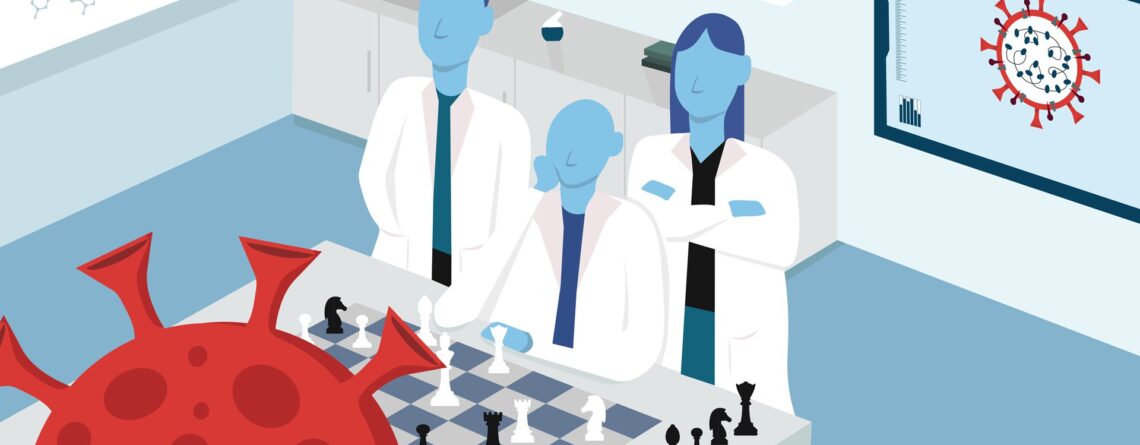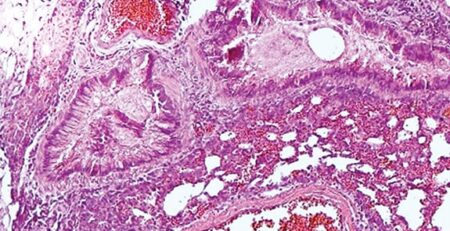Outsmarting Pandemic Viruses
Written by LaTina Emerson
Written by LaTina Emerson
Researchers in the Institute for Biomedical Sciences are focused on developing antiviral drugs and universal vaccines to fight severe acute respiratory syndrome coronavirus 2 (SARS-CoV-2), the virus that causes COVID-19, and other highly pathogenic coronaviruses, including SARS-associated coronavirus (SARS-CoV) and Middle East Respiratory Syndrome coronavirus (MERS-CoV).
They’re targeting key parts of these viruses, such as the spike protein, to block the pathogens from infecting human cells or copying their genetic material. Their pioneering work has received national support, and some of these projects have been selected for inclusion in research centers funded by the National Institutes of Health.
Antiviral Drugs
Richard Plemper, Distinguished University Professor and director of the Center for Translational Antiviral Research, is on a mission to develop candidate COVID-19 antivirals, particularly those that can be taken in an outpatient setting, as well as antivirals targeting specific viral families with high potential to cause a pandemic in the future.
In collaboration with Emory University, Plemper has established a groundbreaking new drug development center at Georgia State and Emory universities that has received $52 million in federal funding to prepare against future pandemic threats. The Antiviral Countermeasures Development Center (AC/DC) is one of nine Antiviral Drug Discovery (AViDD) Centers around the country being funded by the National Institute of Allergy and Infectious Diseases (NIAID).
“These centers will fill the antiviral drug discovery pipeline for the next decade,” Plemper said. “In the AC/DC, we concentrate on developing broad spectrum therapeutics that are effective against viral families of highest pandemic potential.”
To combat SARS-CoV-2 and other pandemic viruses, Plemper and his team are focused on blocking the activity of the viral RNA polymerase complexes, the enzymes that are essential for replication of the viral genome. “The polymerases of RNA viruses are structurally and functionally unique, offering multiple druggable target sites for effective therapeutics,” Plemper said.
In a study published in Science in January 2022, Plemper and his team reported a new candidate ribonucleoside analog, 4’-fluorouridine (4’-FlU), that has potent antiviral activity against SARS-CoV-2, respiratory syncytial virus (RSV) and other respiratory RNA viruses in cell culture, human organoids and different animal models when administered orally once daily.
“Mechanistically, we show that 4’-FlU is in a different class from molnupiravir,” Plemper said. “4’-FlU does not act as a mutagen but induces termination of the viral polymerase, aborting replication of the viral genome. There is an urgent need to expand the therapeutic arsenal against SARS-CoV-2, and 4’-FlU has strong developmental promise to meet this need.”
In the study, 4’-FlU was tested against different SARS-CoV-2 variants of concern in ferrets, which have emerged as a leading model for drug testing, and against RSV in mice. The researchers found that this drug potently blocked SARS-CoV-2 replication, including the gamma and delta variants in the ferret, and efficiently suppressed RSV burden in mouse lungs. They reported that 4’-FlU is “the only orally available antiviral candidate currently developed against SARS-CoV-2 that is active when given once daily.”
Also, in a study published in Nature Communications in July 2022, Plemper and his team developed a dwarf hamster animal model for the omicron variant that recapitulates the clinical appearance of severe COVID-19. Using this model, they demonstrated strong benefit of the SARS-CoV-2 therapeutic molnupiravir against currently circulating variants of the virus.
For the future, Plemper believes that it’s important to develop multiple antiviral drug candidates against pandemic and endemic viruses. “Some endemic viruses, such as respiratory syncytial virus, are the leading cause of infant mortality in the United States from respiratory diseases,” Plemper said. In a study in Science Advances from June 2022, the Plemper team identified an oral antiviral drug that targets a key part of the RSV polymerase and inhibits the synthesis of viral genetic material, a finding that could provide an effective treatment against RSV disease.
“I think we need a small panel of broadly active antivirals pre-approved for human use as a first-line defense against viruses that have spilled over into the human population from animal reservoirs, and I believe that we will see this panel emerging in the next five years,” Plemper said.
Universal Vaccines
Lanying Du, a professor in the Institute for Biomedical Sciences, is working on universal vaccines for SARS-CoV-2 and several pan-coronaviruses, such as SARS-CoV and MERS-CoV.
“There’s an urgent need to develop safe and effective vaccines with broad-spectrum activity against current and future SARS-CoV-2 variants and other coronaviruses with pandemic potential. If we have a vaccine that is universal, we can target all coronaviruses. That would be good preparation for the future. Then, the vaccine won’t need to be adapted for every new variant.”
Du has been studying coronaviruses for 20 years. Her research team has identified critical regions of viral proteins as the key vaccine targets against COVID-19 and diseases caused by SARS-CoV and MERS-CoV.
Since SARS-CoV-2 emerged in 2019, several variants of concern have been identified, including alpha, beta, gamma, delta and omicron variants. The omicron variant can be further divided into the BA.1, BA.2, BA.3, BA.4 and BA.5 subvariants, as well as several new omicron subvariants (BA.2.75.2, BA.4.6, BF.7, BQ.1.1 and XBB) recently identified as potential threats. Most of these SARS-CoV-2 variants, particularly the currently dominant omicron BA.5 subvariant, are highly resistant to neutralizing antibodies generated by the first-generation COVID-19 vaccines that target the original viral spike protein, Du explained. Because the virus keeps mutating and outmaneuvering current vaccines, more than 96 million COVID-19 cases have been reported in the United States as of October 2022, according to the Centers for Disease Control and Prevention (CDC).
In addition, SARS-CoV and MERS-CoV, as well as other coronaviruses from bats or other animal species, have already caused epidemics or may have pandemic potential in the future.
SARS-CoV was first reported in Asia in February 2003 and spread to more than two dozen countries in North America, South America, Europe and Asia before the global outbreak was contained, according to the CDC. It was the first severe and readily transmissible new disease to emerge in the 21st century, the World Health Organization (WHO) reports.
MERS-CoV, a zoonotic virus transferred to humans from infected dromedary camels, has been reported in 27 countries since 2012, leading to almost 860 known deaths (about a 35 percent mortality rate) due to infection and related complications, according to the WHO.
Du’s main research goal is to design and develop structure-based universal COVID-19 vaccines that target multiple SARS-CoV-2 variants of concern and pan-coronavirus vaccines that target various coronaviruses with pandemic potential. The vaccines will be designed to focus on specific coronaviruses or variants. Her work focuses on the spike protein.
“We already identified this protein as the most important target for developing vaccines and therapeutic agents,” Du said. “We originally identified the receptor-binding domain (RBD) of the SARS-CoV-2 spike protein, and designed several promising candidate vaccines based on this region.”
RBD is a key part of a virus located on the spike protein that allows it to attach to body receptors to gain entry into cells and lead to infection. When SARS-CoV-2 and similar viruses, such as SARS-CoV and MERS-CoV, attempt to infect cells, their first step is connecting the RBD region to the body’s receptor. Once the virus and the body’s receptor are bound, the infection continues to the next steps. The virus can’t efficiently infect cells if the RBD region is blocked from binding to the body’s receptors.
As SARS-CoV-2 has undergone continuous mutation resulting in multiple variants, the variants have been found to include mutations in RBD. Du and her team designed structure-based RBD vaccines to improve their efficacy. The team identified an immunodominant non-neutralizing epitope (portion of a foreign protein that diverts effective immune responses) on the SARS-CoV-2 RBD region. A vaccine developed against this mutant RBD, constructed by masking this epitope, had broad-spectrum activity against multiple SARS-CoV-2 variants, as well as the potential to be effective against omicron.
In the future, Du may focus on other regions of the spike protein besides the RBD fragment or other viral proteins to avoid reliance on one target.
“With the variants, we will expand to other critical regions of spike or other proteins,” Du said. “Originally, we used the RBD to target MERS-CoV and SARS-CoV because those viruses don’t have so many variants, unlike SARS-CoV-2, and RBD-based vaccines were highly potent against multiple strains of these viruses. In terms of SARS-CoV-2, we will need to use an advanced approach to improve the efficacy.”
Baozhong Wang, a Distinguished University Professor in the Institute for Biomedical Sciences, is also working on a universal coronavirus vaccine that targets the spike protein. In an article published in the journal Small in May 2022, Wang and his team found that a nanoparticle vaccine that combines two proteins that induce immune responses against SARS-CoV-2 has the potential to be developed into broader and safe SARS-CoV-2 vaccines.
“Our universal coronavirus vaccine research focuses on developing immunogens that generate broadly protective immune responses and nanoparticle vaccine formats that enhance the vigor of the immune responses,” Wang said. “We have reported that we can use a combination of coronavirus spike-related proteins to fabricate protein nanoparticles that induce a wide range of potent immune responses against a broad spectrum of coronavirus strains.”
The study, conducted in mice, investigates the immune responses induced by two proteins, the spike protein and its relatively conserved stem subunit of the spike protein. The results indicate that the assembly of the two proteins into double-layered protein nanoparticles improves the immunogenicity of the proteins.
The spike protein has been used as the major antigen in SARS-CoV-2 vaccines, but as more variants have appeared, the efficacy and protection of current vaccines are under constant threat and need continuous improvement.
The stem portion of the spike is more conserved and has fewer mutations across lineages. In addition, stem-based SARS-CoV-2 vaccines could induce effective antibody responses with broad neutralization and vigorous antibody-dependent cellular cytotoxicity (ADCC) activity against multiple variants of the spike protein. Wang’s work shows that the stabilized stem subunit could be a potential antigen for a SARS-CoV-2 universal vaccine against unpredictable variants.
SARS-CoV-2 evades immune responses by hiding its critical but conserved structures, like the stem of the spike protein. Using the full spike protein as the immunogen, like current SARS-CoV-2 vaccines, vaccination induces responses selective to the RBD and N-terminal domain (NTD) of the spike protein.
“We generated a stabilized spike stem protein and assembled the stem on the nanoparticle surfaces in our vaccine,” Wang said. “Without the more variable and immunodominant RBD and NTD portions, the nanoparticles induced robust responses to the conserved stem of the spike protein, generating broadly reactive immunity for broad protection.”
Illustrations by Erica Dean (B.F.A. ’23); Photos by Meg Buscema












Leave a Reply